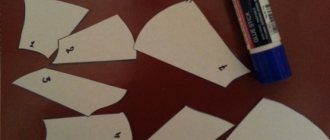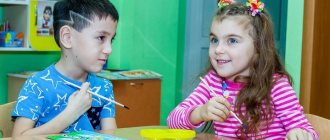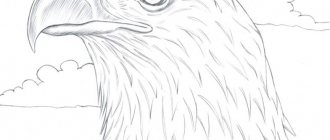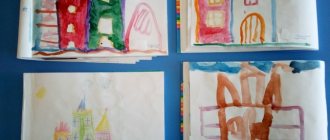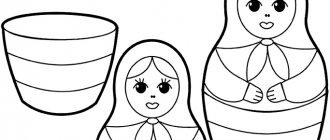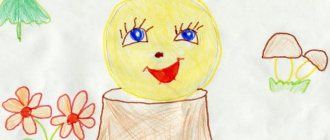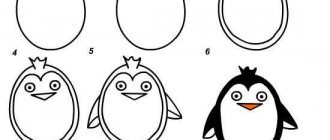Modern interpretation
Abstraction is in fashion today. Therefore, a drawing-portrait of a Russian beauty in a modern interpretation may look unconventional. For example, you can draw a beautiful bun, a nice profile, outline a neck line and an ear. But it is not necessary to draw the face. You can get by with non-trivial shading or, in general, write a poem in place of the eyes and lips. It could even be a favorite verse.
- Introduce the history and traditions of Russian folk holidays.
- Cultivate respect, develop interest in folk art.
- Reinforce the concept of “ornament” and its types.
- Improve your visual skills and the ability to work with gouache.
Visibility:
images of Russian folk costumes, ornaments, panels depicting a village square, audio recording “Ringing of Bells”, templates of human figures, proverbs on the board:
- You can't feed a chicken, and you can't dress up a girl.
- The woman’s shirts are the same bags: tie the sleeves and put whatever you want.
- They praise the silk on a girl when the girl herself has a lot of sense.
I. Organizational moment.
II. Announcing the topic of the lesson
Every nation has holidays. They reveal a person’s soul, his character. In Rus' they loved holidays. They greeted spring and said goodbye to winter; holidays celebrated the completion of field work, and sometimes simply the end of the working day. Holidays were always fun, filled with music, singing, games and dancing. Every evening, people of different ages gathered in someone’s hut in the evening and sang and danced there. The song and dance repertoire was very rich and varied. All seasons, all calendar holidays had their own songs, games, dances, fun, and nursery rhymes. Often, catchphrases, jokes, and jokes were invented on the spot, improvised on the spot, especially ditties.
The holiday is not only songs and dances.
How else does this day differ from ordinary everyday life?/outfits/
On the eve of public festivities, heavy chests were thrown open. The more they were stuffed, the richer the owner of the house was considered. All festive clothing was necessarily decorated with elements of embroidery, beads, and sparkles, which, as a rule, was not present in everyday clothing. One could judge the taste and skill of the craftswoman by her clothes, because the peasant woman made her own outfit.
What a variety of holiday outfits!
What do they have in common? (patterns)
How can you call it differently? (ornament)
Any Russian costume in the old days was certainly decorated with ornaments and embroidery.
Let's remember what types of ornaments you know?
/plant and geometric/
Attention to the board. Before you are patterns (they can simply be depicted on the board with colored chalk.) Which of them will not be ornaments? Why? /in the ornament the elements are depicted in a certain order, rhythmically./
Game “Compose a melody for the ornament.”
b) STORY about Russian folk costumes.
Let's take a closer look at the outfits.
The basis of any Russian costume was the shirt. Shirts with a fastener on the side were called kosovorotki. These were usually worn by men. Their outfit also included pants, which were tucked into boots or onuchi (a piece of fabric), and bast shoes were worn on top of the onuchi.
The shirt was wide and decorated along the hem, collar, and edge of the sleeves with embroidery. And she always tied it with a sash.
Belts performed many functions: they spoke about a person’s well-being, and were also a reward and a gift and were passed on by inheritance. Festive shirts were embroidered with colored silk threads. Preference was given to red color (as a talisman).
Particular importance was attached to the location of the drawing. For example:
- chest patterns - protected the heart and lungs,
- shoulder guards - protected the hands,
- floor-mounted - did not allow evil forces to penetrate from below.
In the central and northern regions of Russia, women wore a sundress on holidays.
The smooth lines of the sundress seemed to flow, making the woman look like a swan. It’s not for nothing that in songs and fairy tales they are called swans.
The festive outfit also included the so-called soul warmers - epanechki or koroten - short blouses with straps, similar to sundresses.
And in the southern regions of Russia, fashionistas wore a pony complex.
Poneva - skirt. She always dressed over a shirt, then an apron, and then a top.
The apron was lavishly decorated with embroidery.
Red color predominated. This is the color of fire, the sun, magical, beautiful, a symbol of salvation and a sign of a barrier to evil forces. This color was supposed to scare away demons and spirits in human form, and to preserve and protect the owner from various misfortunes.
A navershnik is an outer garment worn in the fall or spring. The top was not belted.
And finally, hats.
They were clearly divided into dresses for girls and for married women:
Kokoshniks, ribbons, wreaths /girls/.
Koruna, magpie, kitschka /female/.
In the names of the headdresses one can hear a relationship with a bird: kokoshnik, kichka, magpie. And this is no coincidence. Remember the fairy tales: the swan, the swan is white, like a peahen.
c) Working with proverbs.
III. Practical work
– creation of a collective panel on the theme “Holiday in the Village.”
Students are given figurines depicting people and need to make them festive clothes.
Notes on drawing in the preparatory group “We are young designers”
Summary of the lesson on children's design " We are young designers " in the preparatory group
Goal: to develop in children an idea of design as a field of art in the objective world; about the value of design developments; about the structure of a specific labor process ( modeling , clothing production). Introduction to the new painting technique "frottage".
Tasks:
-Continue, generalize ideas about the connection between the labor of people employed in the same production.
— introduce children to the profession of fashion designer and its purpose.
— Introduce the work of great couturiers and designers (V. Yudashkin, V. Zaitsev).
-Introduce preschoolers to the non-traditional technique of texture drawing, frottage.
— To develop the ability to create design using the knowledge gained when performing practical tasks: decoration ( design ) of modern clothing.
-Improve shading skills, adjust pressure, select colors, strengthen the ability to create a composition.
— Develop the skills necessary for collective creativity, communication skills, observation, creativity, aesthetic taste.
-To develop the ability to bring the job started to completion, to work in a team. Arouse interest in non-traditional visual material and a desire to act with it. — Foster respect for the work of adults.
Material and equipment: pictures depicting great couturiers and designers -V . Zaitsev and his clothing collection, V. Yudashkin and his collection of designer clothing . A box with spools of thread, a tape measure, scissors, needles, chalk, a thimble, a small sewing machine, a piece of fabric, a pattern, a finished dress. Sketches of clothes on A 4 paper, wax crayons, soft colored pencils, various textures for placing under paper, samples of ready-made patterns.
Progress of the lesson
Organizing time
Educator: - Look guys, today I brought a beautiful box class Let's all see what's in it together?
The teacher takes one item out of the box and asks the children to name these items (thread, tape measure, scissors, needles, chalk, thimble, fabric, small sewing machine, pattern, dress style).
Educator: - Well done! Tell me, who works with these objects, and what can be done with the help of these objects? (Children’s answers).
Educator: - List the professions that relate to tailoring? (Cutter, seamstress, tailor, fashion designer) .
Educator: - You correctly named the professions of people who are engaged in tailoring.
- I invite you to play the Question and Answer game with me.
Questions: 1. All people are wearing something, where do they buy their clothes? 2. How did the clothes get into the store? Who sewed it? 3. What are the people who sew clothes called? 4. And if you can’t find what you need in the store, where can you sew clothes? 5. In the atelier, the person who cuts the clothes will take the order. What is the name of his profession? 6. They brought fabric to the seamstress and asked her to sew a dress. Where does she start her work? 7. What should you do before cutting a dress for sewing? 8. Where does a dressmaker get clothing designs ? 9. Who comes up with clothing models ?
— Not all people can sew and design beautiful clothes. You need to study a lot and love doing it, be a dreamer, and have aesthetic taste.
All professions: seamstress, cutter, fashion designer are closely related to each other and are employed in the same production.
Educator: - You are all great and answered all the questions correctly, correctly named the professions that are involved in tailoring and talked about the function of each.
Educator: - In today's lesson Fashion Designer better .
Main part: The teacher's story.
A fashion designer (in the Russian tradition) is a specialist in making clothing models , a clothing designer , a creator of experimental samples, developing decor, choosing colors and materials, thinking through accessories and additions.
— We will now get acquainted with two famous fashion designers who were the first to win recognition and fame in the fashion industry and glorified this creative profession not only in Russia, but also beyond the borders of our Motherland.
Vyacheslav Zaitsev is a couturier, artist, poet, president of the Moscow Fashion House, member of the Union of Artists of the Russian Federation, Honored Artist of the Russian Federation. Man of the Year in the Fashion World.
Born on March 2, 1938 in Ivanovo, in a working-class family. He graduated with honors from the Ivanovo Chemical-Technological College and received a qualification as an artist in textile painting. 1962 - graduated with honors from the Moscow Textile Institute. Worked at an experimental garment factory. Now he heads the Moscow Fashion House. V. Zaitsev conducts multifaceted creative work with young artists, fashion designers and designers . Largely thanks to his efforts, Russian fashion has reached the world level, taking its rightful place . (display of a clothing collection from V. Zaitsev)
Valentin Yudashkin was born on October 14, 1963 in the village of Bakovka, Odintsovo district, Moscow region.
passion for modeling manifested itself in school. Days and nights, the future couturier drew his first “ models ” and brought them to life himself. I made patterns, sewed from everything that came to hand - for myself and for friends. After passing the final exams, there was no question for Valentin where to go to study. The news of his decision upset his parents, who believed that the profession of a fashion designer was “not for men.” In 1981, Valentin entered the Moscow Industrial College at the Faculty of Modeling . Yudashkin was not stopped by the fact that there were only girls in his “ Fashion Design ” course. It turned out that from the very first steps in his profession, Yudashkin represented the Russian fashion industry abroad, collections of his works were demonstrated in all the world’s fashion capitals, some models of Yudashkin’s dresses are in the Museum Louvre costumes. Among celebrities, he is considered the king of wedding fashion. (collection show)
I bring to your attention a collection of other fashion designers who create beautiful dresses not only for adults, but also for children.)
(showing a collection of dresses for girls)
Educator: — Did you like the unusually beautiful, exclusive design works of fashion designers ? (answers)
I'm going to open a school for young ,
Would you, girls and boys, like to go to this school (yes) I’m very glad, but first, I say without further ado
Desire alone is not enough - everyone must be ready: DRAW - DRAW, CUT AND SEW Learn quickly, and for this we all
The School of “Young Fashion Designers ” will be very useful.
Educator: - I enroll everyone in the school of “ Fashion Designers ” and before going to work, I suggest they play the outdoor game “Figure with Scarves.”
(there is a dynamic pause accompanied by musical accompaniment)
Music sounds once, Music sounds two, Music sounds three, Beautiful figure with scarves, freeze. (play 2 times)
Educator: - What beautiful movements you performed to the music, and the figures were interesting, well done.
“And now I ask you to go to school and try yourself as a fashion designer and develop a collection of clothes, and since summer is coming soon, I propose to make a summer collection called “Bright Colors of Summer.” Guys, look at your tables there are clothing models. (Skirt, shorts, dress, T-shirt) - blanks cut out of paper. Choose any model for yourself. But your models are one-color and in order for them to become designer, you need to choose a fabric for them. Now we will paint your models using a technique called frottage. Stencils for our fabric can be any objects with a corrugated surface: a regular comb, napkins, lace, tree leaves, a vegetable grater, design parts, corrugated cardboard, a mosquito net, wallpaper with a convex pattern. You need to take a stencil and place it under your sketch, select wax crayon that you like and shade the model. Using textured surfaces and colored pencils or wax crayons, you can create not only beautiful fabrics, but also original designs.
Educator: Guys, I suggest you choose stencil templates and get to work.
You need to draw carefully, do not go beyond the outline of the figure, paint each detail in one direction, hold the base, select the appropriate colors.
Independent work of children using the Frottage technique. Individual assistance for everyone.
Educator: Today you are all great! You tried very hard, you got good and interesting outfits. Let's arrange an exhibition of works. (works are hung on the board, children comment on their works, each work is discussed).
Educator: - When you become adults, maybe one of you will become a famous fashion designer , cutter or tailor.
Portrait of a princess
If a child has artistic talent, then, in principle, he cannot depict the entire figure on paper. How to draw a portrait of a Russian beauty?
You need to outline the dimensions of the drawing. The face should occupy half or one third of the sheet. Draw an oval and mark the hairline with two semicircles. We immediately draw a kokoshnik. It will look like a pointed semicircle. Princesses wear dresses, so this part of the design needs to be given special attention. In order not to torment your child with images of decor, you can come up with a more complex style of clothing. The girl's figure should resemble an hourglass. But the sleeves can be drawn in the form of several interconnected circles or ovals. You can depict a braid in the same way. We put beads on the beauty's neck. Only the face remains. To avoid the problem that one eye is larger than the other, we draw the girl in a small spread, as if she was slightly turned away from the viewer. We depict the eyes as circles, and give them an almond shape using the eyelashes. We complete the arches of the eyebrows and draw the nose in a small semicircle. All that remains is to outline the lips, and our beauty is ready. You can color the drawing if you wish.
Russian beauty in kokoshnik
At school, when children study the topic of national costume, they are often given homework. How to draw a portrait of a Russian beauty? 4th grade is the time when students can already portray people almost authentically. But drawing portraits is too difficult a task. Therefore, it is better to choose a simpler theme, for example, to depict the entire figure of a girl in a national costume. In such a drawing, a portrait of a Russian beauty in a kokoshnik will also be present, but will not attract increased attention.
In order to depict a girl, we, again, need to arrange the figure on the sheet. So that our beauty doesn’t get bored, we can draw a young guy next to her. Let's start with the image of the girl. We divide the figure into 4 parts. The first of them is devoted to the image of the head and kokoshnik. We draw the face in a circle, and the headdress in a semicircle. Don't forget to make a small point in its center. We use a trapezoid with a rounded edge to represent a sundress. We place the second of our four parts under the arms. We draw them with corners to the trapezoid. We also outline the shoes with triangles. All that remains is to detail the figure, draw the face and the ornament on the sundress and kokoshnik. Using an analogy, we try to portray a young man.
